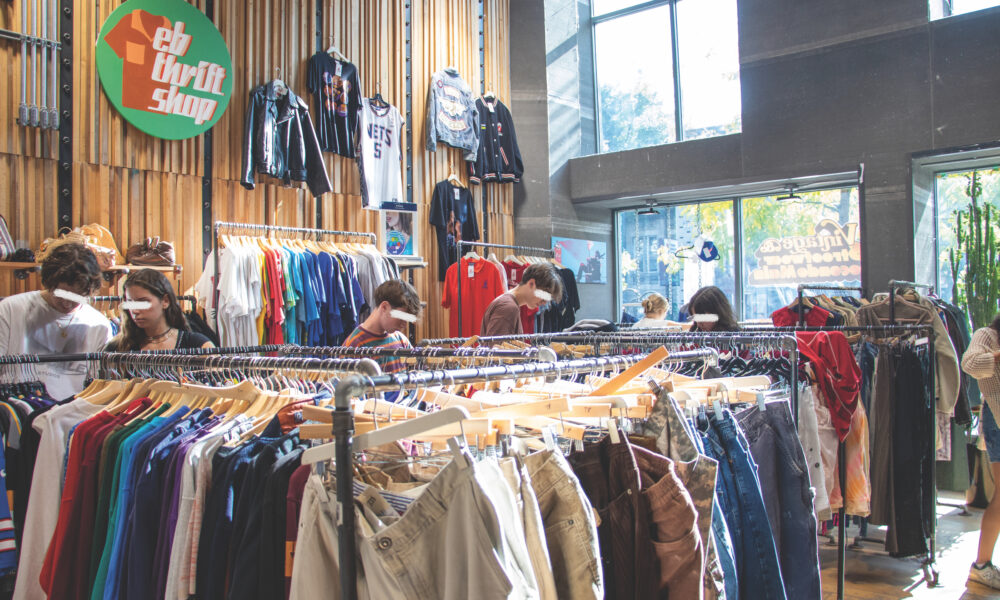You’ve likely seen them on your friends and in your feeds: Tattered Carhartt jeans, 90’s Levi’s, and Nike crewnecks from the 80s. Lately, vintage items have become coveted by Gen Z fashion enthusiasts the world over. There are over 15 million posts under #VintageClothing on Instagram, and even young celebrities like Olivia Rodrigo are wearing retro clothes (albeit fancier fare like Chanel and Prada).
The vintage-clothes frenzy means that a pair of vintage Levi’s can go for upwards of $150. Used sweatshirts from brands such as Patagonia and Ralph Lauren, that could once be found for $5 on sites like Depop and Poshmark, are being scooped up and resold for 20 times as much on the same platforms. Brands like Carhartt and Dickies (historically staples for carpenters and painters) are being worn all over Instagram by kids who have never opened a can of paint, nor held a hammer.
So what makes thrifted clothing so appealing?
A decade ago, the answer might have been sustainability—thrifted clothes are undeniably better for the planet than fast fashion. They are also cheaper, making fashion more accessible to lower-income individuals. But while these answers still hold true today, the hype around thrifting has become less about its practicality and more about achieving a retro look. This can negatively impact people who rely on second-hand retailers for affordable clothing.
As more influencers wear and sell vintage, many people have come to prefer the distressed style and broken-in feeling that gives thrifted clothes their authenticity.
“Wearing jeans from a retail store has that feeling and look that you don’t entirely enjoy, but getting that same pair of jeans from a thrift store is so much better, everything from the style to the worn-in feeling,” Eliot Loose, U0 Arts, explained.
Because of the online conversations around vintage clothing, thrifters are also more informed than ever before about which brands maintain their value over time. Thus, many search for discontinued designs, like the legendary Levi’s Silver Tabs.
“With apps like Depop, you can really find anything,” Myla Seder, a popular Depop seller who sells under the name @mylaseed, said. “Being able to type whatever you’re looking for into a search bar has completely changed thrifting.”
As a result of their cult following, it’s much harder to find desirable brands at a reasonable price, and many mainstream thrift stores like Salvation Army and Renaissance have been completely picked over by people who know what to look for. Thrift stores that still have coveted attire often take advantage of the high demand by hiking their prices. In Montreal, stores like Citizen Vintage and Cul-de-Sac sell used T-shirts for more than $20 and jeans for up to $150.
Many shoppers don’t mind paying for a curated selection, and shop owners know that many would rather spend more money to know that what they’re getting is legitimate, rather than risk sifting around actual “thrift” stores for hours, potentially leaving empty-handed.
“There’s a lot of fun in sharing ideas about new styles and selling clothes that you’re interested in,” Erika Bonneville of La Caravane Vintage, one of Montreal’s many higher-end, curated shops, explained. “For example, my business partner loves old Western clothing, so it’s nice for him to find items that he’s actually interested in, and it’s fun for us to share our knowledge and love for vintage clothing.”
But do these curated stores take away from one of the fundamental appeals of thrifting—finding a gem for little-to-no money? And how does that squeeze the customers both online and off?
“For a long time, Depop and Etsy were great and boosting traffic for the store and finding new pieces,” Bonneville said. “But nowadays, they’re taking bigger cuts and are huge competition for small businesses.”
Nobody knows how thrift culture might change in the coming years, or when Gen Z will tire of it, but it’s hard to imagine that it’ll ever return to the treasure hunt it once was.









